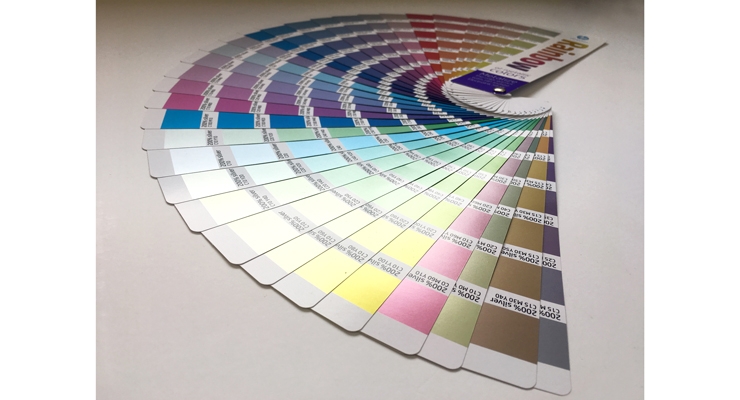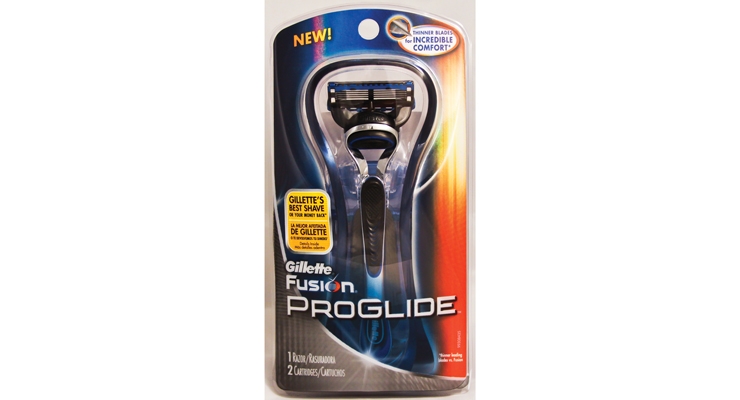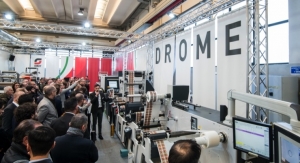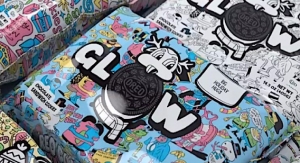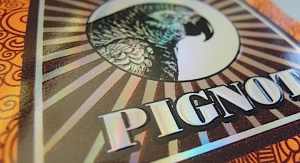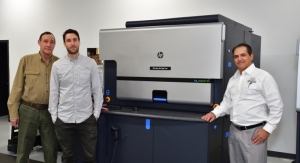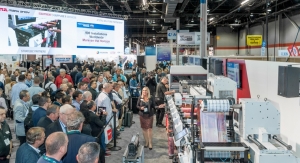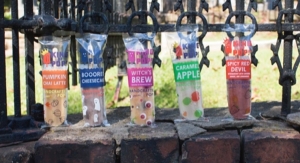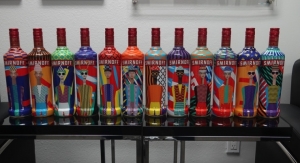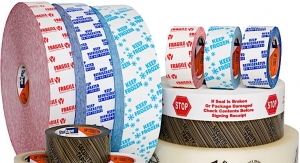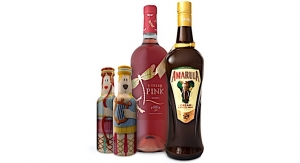Greg Hrinya, Associate Editor02.01.19
Consumers will often make assumptions about the quality of a product based on the quality of the packaging. Metallic effects utilized on a label provide that perceived quality. Whether through the inks, substrates or enhancement techniques, such as foiling, converters can deliver the luster and shine that illuminate a brand on the shelf.
Many different markets can benefit from metallic effects, especially those that want to convey luxury. From nutritional products to various consumables, a high-value product design is required to elevate a brand’s image. Historically, price prohibited everyday items from using metallic effects, rendering them useful only in high-end segments like wine and spirits, and energy drinks. Today, however, nearly every end use can benefit from these enhancements.
“The decision to apply special finishes is typically driven by the package designer and/or brand owner seeking to create a unique brand image or to simply enhance shelf appeal,” explains Timothy Cain, president of Breit Technologies. “All labeling of consumer whole goods plays a critical role in brand perception, whether bought online or off the shelf. Products purchased online eventually end up being seen and held by the consumer – adding to any exiting brand perception after the purchase. Attractive product packaging on the shelves at brick and mortar stores can impact both brand perception and purchase.”
There is a science behind applying metallic effects, too. “There have been many studies conducted that show foil decoration increases purchases versus traditional print by 40%, and the likelihood of positive eye tracking results by up to 80%,” notes Allan Quimby, sales and marketing manager at KURZ. “Wine and spirits have already exhibited how transforming the perceived value of the product is achievable through foil decoration. Including foil and embossing effects into the design gives a unique and premium look with visibly tactile brilliance and texture.”
“A lot of wines have an essence of sparkly, bubbly that these metallic effects match,” adds Vanita Marzette, senior product manager – Specialty, at Avery Dennison. “These types of materials make brands stand out, and there is also a range of how much metallic effects brands choose to incorporate.”
KURZ provides foils to meet any commercial application and substrate. The company will recommend the best foil and/or application method depending on the design and converting method selected. KURZ offers hot stamping foils, cold foils, digital foils, or a combination of the above to achieve the required results of the brand. With many options available, it might be hard to determine a course of action.
“There are multiple factors to consider when deciding what method is best for decoration,” explains Quimby. “It could be the overall end appearance, the feel and look desired. It could be the desired substrate, limiting the method of best application. Run quantities also play a part in the best method as well as the converter’s equipment and capabilities. Digital, for example, is preferred for shorter runs, and it’s the only method that includes variable content capabilities. All of these factors are important to consider even before starting the design process. Without realistic expectations of execution and understanding each of these print processes and their limitations, it could be either impossible to print or either result in a label that doesn’t look as expected. KURZ specializes in assisting converters and brand owners in both consultative and support roles, as well as directly supplying the foils, tooling, technical support, and equipment required.”
K Laser, a provider of holographic and metalized print substrates, offers a large amount of cold foil products, with 20 metallic colors, hundreds of holographic patterns ranging from decorative, security, metal effect and custom holographic patterns. The company notes that each process has its pros and cons. “The main factors when choosing a decoration method are design, cost, availability and quality,” says Mike Rivera, vice president, CFBU, at K Laser. “If the artwork requires inks to be printed on top of the foil, cold foil is the best choice since cold foil is more overprintable than hot stamp foils. Hot stamp still provides the best stamping quality but at a higher cost. Cold foil, in the meantime, can provide faster turnaround since it does not require metal dies.”
Foil transfer is key in improving the metallic effect and the brilliance of cold foil. Cyngient has developed a line of adhesives call HYPERcure thin layer transfer. HYPERcure adhesive is produced through a filtration process and proprietary chemistry that increases the transfer through a thin layer application, which increases the reflective value of cold foil to a mirror image. “The reason for the increased reflective value with metallic cold foil is due to the reduction of peaks and valleys caused by tackifiers, typically used in adhesives,” explains Andrew Wasserman, managing partner of Cyngient. HYPERcure is a thin layer technology, which requires less adhesive volume and increased smoothness for higher brilliance and flexibility needed for shrink sleeves and labels.”
Metallic inks, which generate such attractive designs, are available in several grades. According to Mark Geeves, director of sales and marketing at Color-Logic, standard metallic inks are reflective, while inks made with vacuum metalized pigments (VMP) are more lustrous. HP recently launched HP Indigo ElectroInk Silver to provide a wide range of metallic colors in a single digital process while also eliminating the need for metallic substrates.
US-based Innovative Labeling Solutions beta tested HP Indigo ElectroInk Silver, and is now offering the ink to its customers. “Eye-catching metallic designs can be achieved while maintaining the benefits of digital printing, including easily and cost effectively changing the metallic effect from version to version,” says Kristen Waite, marketing communications manager at ILS.
ILS is printing silver ink on clear BOPP, and its customers are finding it to be a viable, economical alternative to using a hot stamp when trying to achieve custom metallic designs for different versions and label sizes in a product line. “By using silver ink, they avoided the upfront tooling costs they would have incurred for each design, and each label size,” adds Waite.
From a substrates standpoint, Avery Dennison recommends metalized films and papers. The company offers its new Luminous collection to provide a subtle sparkle. Thicker papers are frequently utilized, as well, as they are easily enhanced with decorative effects.
With lowering costs, there is greater prevalence of metallic effects in packaging. “We see an increasing demand for embellishment in our target markets, and market pioneers additionally show a permanent interest in new embellishment technologies,” says Pantec’s Michael Damm.
Certain applications will benefit from specific enhancements. According to Damm, foil stamping works well on closed substrates, such as PP, and flatbed foil stamping is perfect for open, structured materials often seen in wine and spirits. Plus, brands are opting for new effects like Fresnel lenses and spatial 3D patches. Embossing is also a popular decoration feature to add to foiling.
Pantec provides several foiling systems to meet market demand. The Swift and Cheetah lines are inline foil stamping systems with modes for insetting in register (lenses, holograms), foil saving and continuous operation. Meanwhile, the Rhino flatbed hot foil embossing system operates at 30,000 strokes per hour, with two foil saving patterns, as well as splice detection and automatic pressure release.
Multi-foil embossing can occur in a single pass at high speeds. For example, three strokes can design with up to 68 m/m. “Embossing quality is best if done with a single tool, as it avoids register error between the stamping and embossing stations,” says Damm. “Combined stamping and embossing in rotary is difficult because tools are very complicated and expensive in production. The process is usually done in flatbed: zero register.”
In addition to aesthetic appeal, there are security and brand protection benefits that metallic effect labels provide. Since they are difficult to copy, metallic effects labels serve a valuable anti-counterfeiting function. “When metallic colors and decorative effects are combined, the labels produced are far more difficult to replicate than those produced with only process colors,” explains Geeves. “Advancements in color management and ICC profiles to match process colors permit easily copying conventional labels. But with metallic colors, counterfeiting requires significantly more advanced skill sets.”
The Color-Logic process, according to Geeves, enables brands that are using silver inks to create decorative effects and gradate two or more metallic colors into a design. These labels are visually appealing and difficult to copy. Plus, they are easy to verify visually as a genuine label, he says.
Keeping costs down
For many years, the high-end price tag of a luxury product rang true for the label, as well. While cost is still a concern, industry advancements have mitigated that challenge to an extent. According to K Laser’s Rivera, cold foil costs have reduced substantially over the years and are now priced the same as hot stamp foils. In some cases, cold foil prices are actually lower than hot stamp foils.
With lower costs associated with metallic enhancements, more markets are taking advantage of this packaging trend. “Truthfully, any market can benefit from foil enhancements from the premium or luxury space down to the commodity items,” says KURZ’s Quimby. “Foil has become such a heavily used and affordable marketing medium that it’s a requirement of most brand owners today rather than the exception.”
Quimby says foil is no longer a limiting factor for speed, quality or color availability. These same trends and advancements continue to repeat as digital printing and foil requirement technologies continue to develop and grow.
Color-Logic’s Geeves states that press manufacturers have developed new technologies to keep costs down, and this is particularly true with setup time. According to Geeves, Color-Logic has developed the only commercially available color communication system, featuring 250 metallic colors for metallic inks, metallic substrates and foils. This system takes into account the color, substrate, process inks, press conditions and coatings chosen for a given application. “Color-Logic creates 250 metallic colors and unlimited decorative effects while using only five colors – silver ink or foil with CMYK inks, or white ink with CMYK on a metallic stock,” explains Geeves. “All Color-Logic special effects are created at the design stage, thus reducing time-to-market and the costs usually associated with implementing metallics.”
In addition, Color-Logic offers the FX-Viewer, which is visualization software that enables a graphic designer to see the effects on his or her monitor before going to press. Color-Logic’s software analyzes the converter’s press configuration and need for post-finishing – caall at the design stage.
“Before Color-Logic, cost was always a critical factor in the metallics decision,” says Geeves. “Cost remains a factor, and ever-increasing number of SKUs used by brands necessitate a strategy for the number of colors required for a product family. Moreover, market competitiveness makes having a “wow” factor over competition more important than ever.”
Cast and Cure
Breit Technologies has emerged as a global supplier of Cast and Cure decorative films. This decorative coating process utilizes “casting” and “curing” techniques to form a consistent high-quality surface, such as ultra-high gloss, matte and holographic finishes, on a variety of substrates.
According to Breit Technologies’ Cain, the Cast and Cure process begins when a UV-curable coating is applied directly to a printed web. A web of Cast and Cure film is then laminated to the wet surface via a nip station. The film’s unique micro-embossed surface then imparts, or “casts,” its pattern onto the coated surface.
“The reflective, refractive and holographic look of labels with Cast and Cure finishes can provide a unique and dynamically interesting finish unlike most all other foil applications. Additionally, the process can be applied to almost any substrate that can be UV coated,” explains Cain. “Printed patterns can move, shimmer and shine – creating a ‘wow’ factor, as well as a high-tech aura.”
UV stations are commonly used immediately inline to dry, or “cure,” the coating and give permanency to the new surface pattern. Following the curing process, the Cast and Cure film is delaminated from the printed web and rewound, allowing the film to be reused again and again.
Unlike foils, which are consumed with each application, there is no material transferred to the printed web during this process. Depending upon the chosen application and equipment, films could conceivably be used between 10-20 times. A hallmark of this process is also better recyclability. Treated products are fully recyclable, and the usage of UV and EB varnishes means no VOCs are being released during application.
Better equipment is normally recommended to ensure consistency and maximize films for reuse, but a standard cold foil setup provides a good entry point in this market.
“Cast and Cure film applications continue to grow more and more popular with major consumer brands seeking to create greater visual product appeal while enjoying the production economies that come from the extended film life,” says Cain.
Digital Options
Digital printing is increasingly becoming a viable option for producing metallic effect labels. By lowering costs and catering to a short-run market, niche brands can take advantage of digital printing technology to stand out on the shelf.
HP Indigo ElectroInk Silver was developed to save media costs and bypass the need for metallic substrates. HP users do not need to rely on metallic materials, as digital printing can take place on a variety of media such as clear or transparent substrates. By printing digitally, converters can capitalize on SKU proliferation.
“This ink breakthrough brings new packaging design possibilities for a wide range of applications, from beverage and spirits to cosmetics and the industrial and chemical markets,” says Yogev Barak, head of strategy and business management, HP Indigo. “Feedback from HP Indigo owners using HP Indigo ElectroInk silver has been amazing. Precision Label just launched production with silver ink and is already reporting success.”
According to Angelo Quagliata, vice president of sales at Precision Label, “We are getting excellent results printing fine type and vignettes in silver and can produce virtually any metallic color by printing process colors over the silver. Digitally printed silver ink is a big plus for our customers who want digital printing benefits without compromising on metallic effects, especially cosmetics companies that need a higher-end look.”
HP has also released HP Indigo GEM technology, which enables a range of tactile metallic effects using combinations of the most common embellishments. These include spot varnish and foils, with the capability to add VDP and HP Mosaic. Working in configuration with an HP Indigo 6900 digital press, the process takes place in one pass and requires just one operator to produce printed and embellished labels.
White ink is critical for digitally-printed metallic effect labels. According to Color-Logic, most digital presses only have white ink available. Geeves notes that Color-Logic is compatible with all the digital presses providing white ink, and HP Indigo ElectroInk Silver, designed for the HP Indigo 6900 series presses, has been certified for use in Color-Logic designs.
“Digital white inks are getting continuously better, with regard to the increased whiteness and the opacity needed when working with metallic stocks,” he says. “Without white ink, metallic stocks produce labels with a less lustrous appearance, since the metallic substrate overpowers the label design.”
Additionally, Color-Logic’s system software, which works equally for digital as it does for flexo, eliminates the need for creating white ink masks manually at the design stage. Designers can therefore create more elaborate embellishments without editing the file in prepress, allowing faster time to market and greater repeatability.
“Digital printing produces metallic labels with high-quality color,” says Geeves. “Some UV digital presses enable converters to print multiple hits of white or clear to add label texture, as well. However, the majority of digital presses require post-finishing to produce labels with special effects. In today’s market, we see diverse brands using metallic labels for differentiation. A key factor with regard to digital presses is their ability to personalize or add variable data, a big reason for moving to digital or hybrid printing.”
Many different markets can benefit from metallic effects, especially those that want to convey luxury. From nutritional products to various consumables, a high-value product design is required to elevate a brand’s image. Historically, price prohibited everyday items from using metallic effects, rendering them useful only in high-end segments like wine and spirits, and energy drinks. Today, however, nearly every end use can benefit from these enhancements.
“The decision to apply special finishes is typically driven by the package designer and/or brand owner seeking to create a unique brand image or to simply enhance shelf appeal,” explains Timothy Cain, president of Breit Technologies. “All labeling of consumer whole goods plays a critical role in brand perception, whether bought online or off the shelf. Products purchased online eventually end up being seen and held by the consumer – adding to any exiting brand perception after the purchase. Attractive product packaging on the shelves at brick and mortar stores can impact both brand perception and purchase.”
There is a science behind applying metallic effects, too. “There have been many studies conducted that show foil decoration increases purchases versus traditional print by 40%, and the likelihood of positive eye tracking results by up to 80%,” notes Allan Quimby, sales and marketing manager at KURZ. “Wine and spirits have already exhibited how transforming the perceived value of the product is achievable through foil decoration. Including foil and embossing effects into the design gives a unique and premium look with visibly tactile brilliance and texture.”
“A lot of wines have an essence of sparkly, bubbly that these metallic effects match,” adds Vanita Marzette, senior product manager – Specialty, at Avery Dennison. “These types of materials make brands stand out, and there is also a range of how much metallic effects brands choose to incorporate.”
KURZ provides foils to meet any commercial application and substrate. The company will recommend the best foil and/or application method depending on the design and converting method selected. KURZ offers hot stamping foils, cold foils, digital foils, or a combination of the above to achieve the required results of the brand. With many options available, it might be hard to determine a course of action.
“There are multiple factors to consider when deciding what method is best for decoration,” explains Quimby. “It could be the overall end appearance, the feel and look desired. It could be the desired substrate, limiting the method of best application. Run quantities also play a part in the best method as well as the converter’s equipment and capabilities. Digital, for example, is preferred for shorter runs, and it’s the only method that includes variable content capabilities. All of these factors are important to consider even before starting the design process. Without realistic expectations of execution and understanding each of these print processes and their limitations, it could be either impossible to print or either result in a label that doesn’t look as expected. KURZ specializes in assisting converters and brand owners in both consultative and support roles, as well as directly supplying the foils, tooling, technical support, and equipment required.”
K Laser, a provider of holographic and metalized print substrates, offers a large amount of cold foil products, with 20 metallic colors, hundreds of holographic patterns ranging from decorative, security, metal effect and custom holographic patterns. The company notes that each process has its pros and cons. “The main factors when choosing a decoration method are design, cost, availability and quality,” says Mike Rivera, vice president, CFBU, at K Laser. “If the artwork requires inks to be printed on top of the foil, cold foil is the best choice since cold foil is more overprintable than hot stamp foils. Hot stamp still provides the best stamping quality but at a higher cost. Cold foil, in the meantime, can provide faster turnaround since it does not require metal dies.”
Foil transfer is key in improving the metallic effect and the brilliance of cold foil. Cyngient has developed a line of adhesives call HYPERcure thin layer transfer. HYPERcure adhesive is produced through a filtration process and proprietary chemistry that increases the transfer through a thin layer application, which increases the reflective value of cold foil to a mirror image. “The reason for the increased reflective value with metallic cold foil is due to the reduction of peaks and valleys caused by tackifiers, typically used in adhesives,” explains Andrew Wasserman, managing partner of Cyngient. HYPERcure is a thin layer technology, which requires less adhesive volume and increased smoothness for higher brilliance and flexibility needed for shrink sleeves and labels.”
Metallic inks, which generate such attractive designs, are available in several grades. According to Mark Geeves, director of sales and marketing at Color-Logic, standard metallic inks are reflective, while inks made with vacuum metalized pigments (VMP) are more lustrous. HP recently launched HP Indigo ElectroInk Silver to provide a wide range of metallic colors in a single digital process while also eliminating the need for metallic substrates.
US-based Innovative Labeling Solutions beta tested HP Indigo ElectroInk Silver, and is now offering the ink to its customers. “Eye-catching metallic designs can be achieved while maintaining the benefits of digital printing, including easily and cost effectively changing the metallic effect from version to version,” says Kristen Waite, marketing communications manager at ILS.
ILS is printing silver ink on clear BOPP, and its customers are finding it to be a viable, economical alternative to using a hot stamp when trying to achieve custom metallic designs for different versions and label sizes in a product line. “By using silver ink, they avoided the upfront tooling costs they would have incurred for each design, and each label size,” adds Waite.
From a substrates standpoint, Avery Dennison recommends metalized films and papers. The company offers its new Luminous collection to provide a subtle sparkle. Thicker papers are frequently utilized, as well, as they are easily enhanced with decorative effects.
With lowering costs, there is greater prevalence of metallic effects in packaging. “We see an increasing demand for embellishment in our target markets, and market pioneers additionally show a permanent interest in new embellishment technologies,” says Pantec’s Michael Damm.
Certain applications will benefit from specific enhancements. According to Damm, foil stamping works well on closed substrates, such as PP, and flatbed foil stamping is perfect for open, structured materials often seen in wine and spirits. Plus, brands are opting for new effects like Fresnel lenses and spatial 3D patches. Embossing is also a popular decoration feature to add to foiling.
Pantec provides several foiling systems to meet market demand. The Swift and Cheetah lines are inline foil stamping systems with modes for insetting in register (lenses, holograms), foil saving and continuous operation. Meanwhile, the Rhino flatbed hot foil embossing system operates at 30,000 strokes per hour, with two foil saving patterns, as well as splice detection and automatic pressure release.
Multi-foil embossing can occur in a single pass at high speeds. For example, three strokes can design with up to 68 m/m. “Embossing quality is best if done with a single tool, as it avoids register error between the stamping and embossing stations,” says Damm. “Combined stamping and embossing in rotary is difficult because tools are very complicated and expensive in production. The process is usually done in flatbed: zero register.”
In addition to aesthetic appeal, there are security and brand protection benefits that metallic effect labels provide. Since they are difficult to copy, metallic effects labels serve a valuable anti-counterfeiting function. “When metallic colors and decorative effects are combined, the labels produced are far more difficult to replicate than those produced with only process colors,” explains Geeves. “Advancements in color management and ICC profiles to match process colors permit easily copying conventional labels. But with metallic colors, counterfeiting requires significantly more advanced skill sets.”
The Color-Logic process, according to Geeves, enables brands that are using silver inks to create decorative effects and gradate two or more metallic colors into a design. These labels are visually appealing and difficult to copy. Plus, they are easy to verify visually as a genuine label, he says.
Keeping costs down
For many years, the high-end price tag of a luxury product rang true for the label, as well. While cost is still a concern, industry advancements have mitigated that challenge to an extent. According to K Laser’s Rivera, cold foil costs have reduced substantially over the years and are now priced the same as hot stamp foils. In some cases, cold foil prices are actually lower than hot stamp foils.
With lower costs associated with metallic enhancements, more markets are taking advantage of this packaging trend. “Truthfully, any market can benefit from foil enhancements from the premium or luxury space down to the commodity items,” says KURZ’s Quimby. “Foil has become such a heavily used and affordable marketing medium that it’s a requirement of most brand owners today rather than the exception.”
Quimby says foil is no longer a limiting factor for speed, quality or color availability. These same trends and advancements continue to repeat as digital printing and foil requirement technologies continue to develop and grow.
Color-Logic’s Geeves states that press manufacturers have developed new technologies to keep costs down, and this is particularly true with setup time. According to Geeves, Color-Logic has developed the only commercially available color communication system, featuring 250 metallic colors for metallic inks, metallic substrates and foils. This system takes into account the color, substrate, process inks, press conditions and coatings chosen for a given application. “Color-Logic creates 250 metallic colors and unlimited decorative effects while using only five colors – silver ink or foil with CMYK inks, or white ink with CMYK on a metallic stock,” explains Geeves. “All Color-Logic special effects are created at the design stage, thus reducing time-to-market and the costs usually associated with implementing metallics.”
In addition, Color-Logic offers the FX-Viewer, which is visualization software that enables a graphic designer to see the effects on his or her monitor before going to press. Color-Logic’s software analyzes the converter’s press configuration and need for post-finishing – caall at the design stage.
“Before Color-Logic, cost was always a critical factor in the metallics decision,” says Geeves. “Cost remains a factor, and ever-increasing number of SKUs used by brands necessitate a strategy for the number of colors required for a product family. Moreover, market competitiveness makes having a “wow” factor over competition more important than ever.”
Cast and Cure
Breit Technologies has emerged as a global supplier of Cast and Cure decorative films. This decorative coating process utilizes “casting” and “curing” techniques to form a consistent high-quality surface, such as ultra-high gloss, matte and holographic finishes, on a variety of substrates.
According to Breit Technologies’ Cain, the Cast and Cure process begins when a UV-curable coating is applied directly to a printed web. A web of Cast and Cure film is then laminated to the wet surface via a nip station. The film’s unique micro-embossed surface then imparts, or “casts,” its pattern onto the coated surface.
“The reflective, refractive and holographic look of labels with Cast and Cure finishes can provide a unique and dynamically interesting finish unlike most all other foil applications. Additionally, the process can be applied to almost any substrate that can be UV coated,” explains Cain. “Printed patterns can move, shimmer and shine – creating a ‘wow’ factor, as well as a high-tech aura.”
UV stations are commonly used immediately inline to dry, or “cure,” the coating and give permanency to the new surface pattern. Following the curing process, the Cast and Cure film is delaminated from the printed web and rewound, allowing the film to be reused again and again.
Unlike foils, which are consumed with each application, there is no material transferred to the printed web during this process. Depending upon the chosen application and equipment, films could conceivably be used between 10-20 times. A hallmark of this process is also better recyclability. Treated products are fully recyclable, and the usage of UV and EB varnishes means no VOCs are being released during application.
Better equipment is normally recommended to ensure consistency and maximize films for reuse, but a standard cold foil setup provides a good entry point in this market.
“Cast and Cure film applications continue to grow more and more popular with major consumer brands seeking to create greater visual product appeal while enjoying the production economies that come from the extended film life,” says Cain.
Digital Options
Digital printing is increasingly becoming a viable option for producing metallic effect labels. By lowering costs and catering to a short-run market, niche brands can take advantage of digital printing technology to stand out on the shelf.
HP Indigo ElectroInk Silver was developed to save media costs and bypass the need for metallic substrates. HP users do not need to rely on metallic materials, as digital printing can take place on a variety of media such as clear or transparent substrates. By printing digitally, converters can capitalize on SKU proliferation.
“This ink breakthrough brings new packaging design possibilities for a wide range of applications, from beverage and spirits to cosmetics and the industrial and chemical markets,” says Yogev Barak, head of strategy and business management, HP Indigo. “Feedback from HP Indigo owners using HP Indigo ElectroInk silver has been amazing. Precision Label just launched production with silver ink and is already reporting success.”
According to Angelo Quagliata, vice president of sales at Precision Label, “We are getting excellent results printing fine type and vignettes in silver and can produce virtually any metallic color by printing process colors over the silver. Digitally printed silver ink is a big plus for our customers who want digital printing benefits without compromising on metallic effects, especially cosmetics companies that need a higher-end look.”
HP has also released HP Indigo GEM technology, which enables a range of tactile metallic effects using combinations of the most common embellishments. These include spot varnish and foils, with the capability to add VDP and HP Mosaic. Working in configuration with an HP Indigo 6900 digital press, the process takes place in one pass and requires just one operator to produce printed and embellished labels.
White ink is critical for digitally-printed metallic effect labels. According to Color-Logic, most digital presses only have white ink available. Geeves notes that Color-Logic is compatible with all the digital presses providing white ink, and HP Indigo ElectroInk Silver, designed for the HP Indigo 6900 series presses, has been certified for use in Color-Logic designs.
“Digital white inks are getting continuously better, with regard to the increased whiteness and the opacity needed when working with metallic stocks,” he says. “Without white ink, metallic stocks produce labels with a less lustrous appearance, since the metallic substrate overpowers the label design.”
Additionally, Color-Logic’s system software, which works equally for digital as it does for flexo, eliminates the need for creating white ink masks manually at the design stage. Designers can therefore create more elaborate embellishments without editing the file in prepress, allowing faster time to market and greater repeatability.
“Digital printing produces metallic labels with high-quality color,” says Geeves. “Some UV digital presses enable converters to print multiple hits of white or clear to add label texture, as well. However, the majority of digital presses require post-finishing to produce labels with special effects. In today’s market, we see diverse brands using metallic labels for differentiation. A key factor with regard to digital presses is their ability to personalize or add variable data, a big reason for moving to digital or hybrid printing.”


